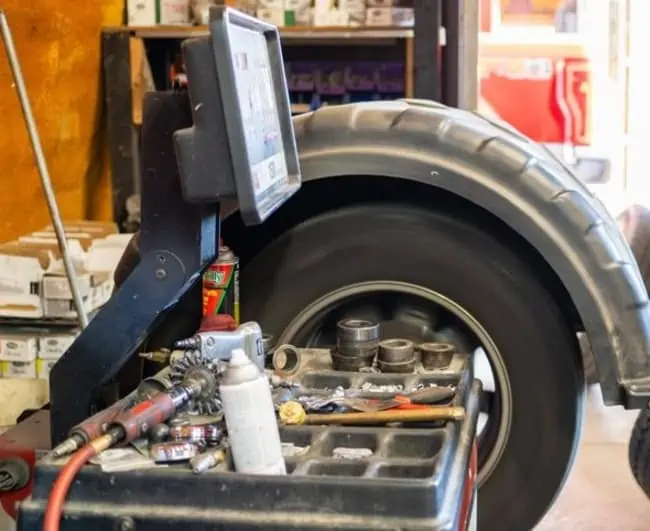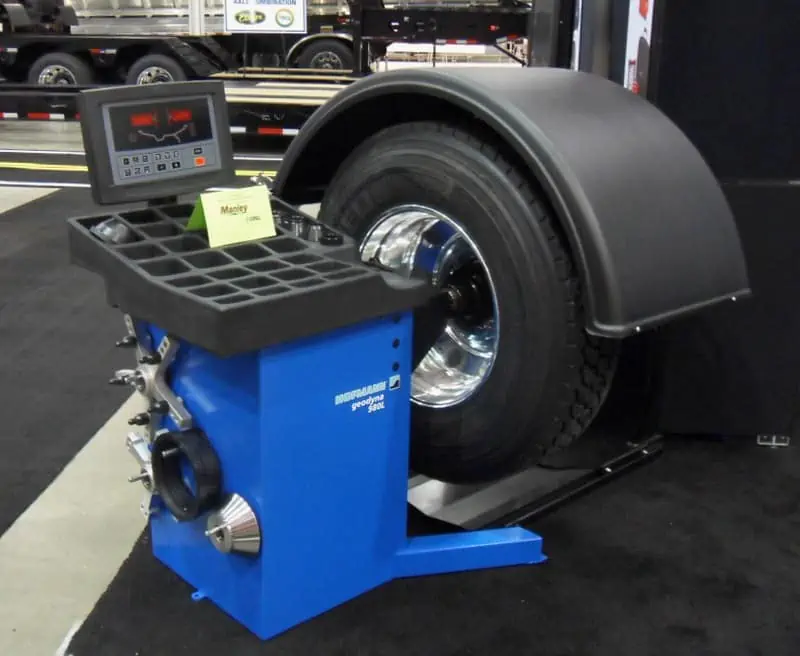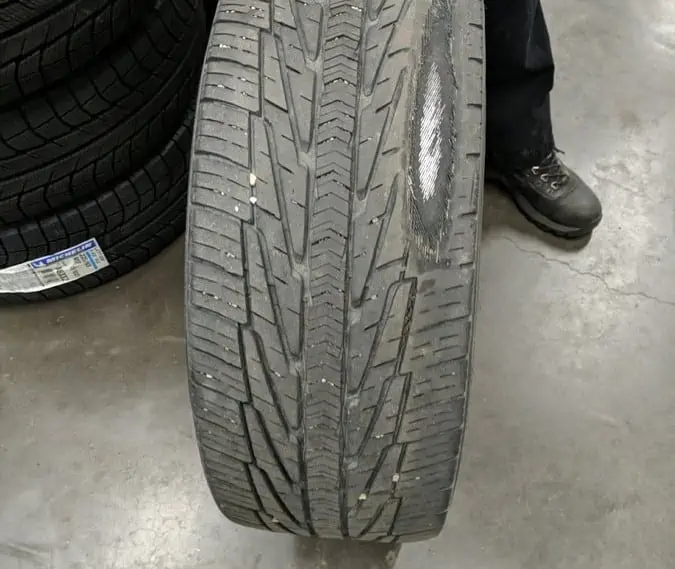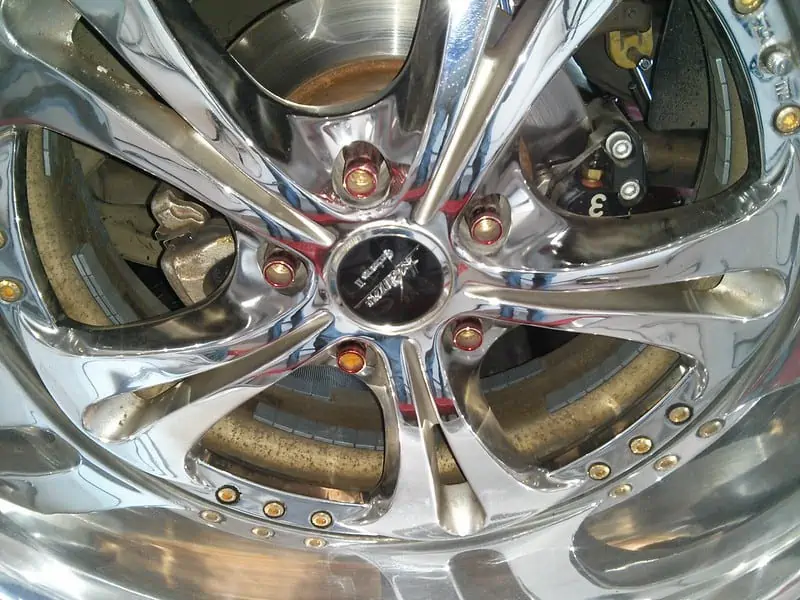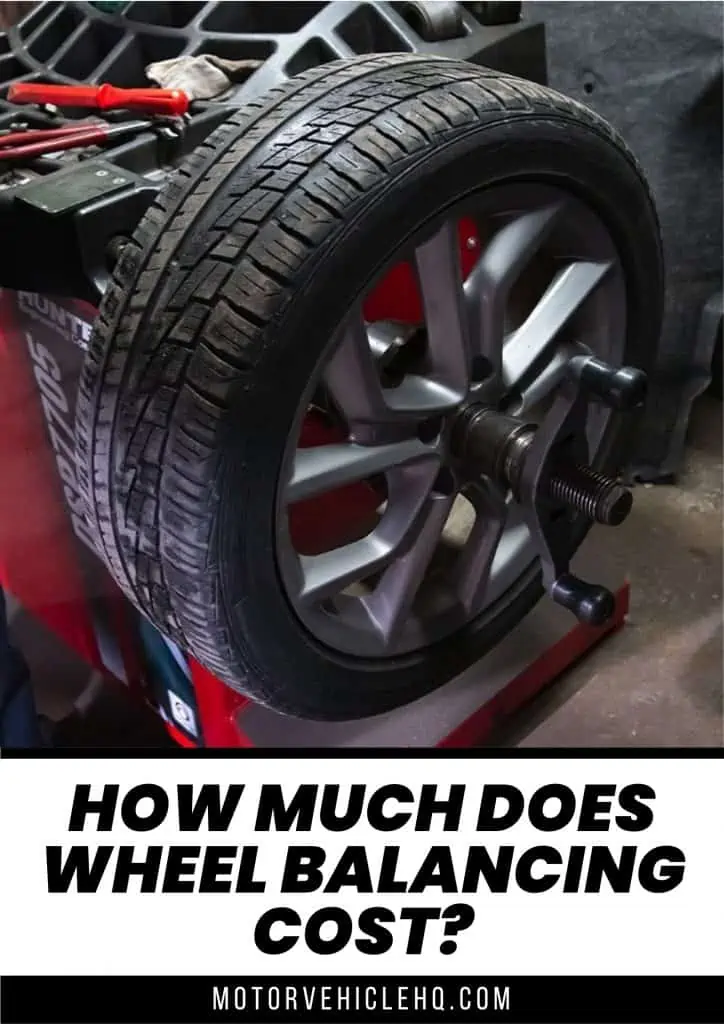One of the most important things you can do to ensure a comfortable driving experience is to get your wheels correctly balanced. This means ensuring the car’s weight is evenly distributed across all four wheels. This is crucial since ignoring wheel balancing can cause issues with your car’s steering capabilities, and problems with your suspension system, which may lead to poor handling and reduced fuel economy. If left unchecked, this might result in poor gas mileage and early wear on your brakes and other essential components of your vehicle.
In this article, we will provide an overview of automotive wheel balancing; including cost, and how it might be advantageous.
Wheel Balancing Cost
Wheel balancing process / self taken. Balancing entails placing the wheel assembly on a balancer, which centers the wheel and spins it to determine where the weights should go. The valve stem hole in the wheel will then subtract a small amount of weight from one side of the wheel.
The average cost of wheel balancing for all four wheels of your car ranges from $30 to $100. Most vehicle repair shops charge an average of $40 for balancing, $20 for mounting, and $12 for the rotation of four wheels. Alternatively, they charge an average of $48 for a complete tire installation package that includes wheel rotation, mounting, balancing, and the installation of a new valve stem for all four wheels.
It is also worth mentioning that wheel-balancing services are often more expensive at automobile dealerships than at tire shops, or independent auto repair shops. For example, you can have your four wheels balanced at a regular tire shop chain for roughly $15 per wheel, while a car dealership may charge you between $20 and $25 per wheel, depending on the type and model.
The cost can vary depending on the type of wheels and the quality of the job, so it is always worth shopping around to get the best deal possible. It is also a good idea to check online customer reviews before you choose a wheel balancer, so you can find out what other customers have to say about the service offered.
Wheel Balancing and Types
A wheel balancer by Tino Rossini / CC BY 2.0. When a wheel is first put onto a vehicle with a new tire, it must be balanced to ensure that the weight is distributed properly across all of the wheels and tires on the vehicle.
Wheel balancing is a term used to describe the process of adjusting the distribution of weight on one or more wheels to improve handling. It is a common modification made to improve the handling of vehicles.
On most vehicles, the front wheels are usually heavier than the rear wheels to give them better traction. If you flip a wheel over so that the heavy side is now on the bottom, you may notice that the wheel is out of balance. This can cause vibrations in the vehicle that can lead to problems with the steering system and shorten the life of the tires. To fix the problem, you must redistribute the weight on the wheel so that it is equal on both sides.
A complete wheel balance includes tire mounting and tire rotation. Tire mounting is the process of placing the tire on the wheel, while tire rotation is the process of changing the specific placements of individual tires on the vehicle.
There are three approaches that a mechanic can take when balancing an uneven wheel — the most common being wheel weights. Wheel weights are little metal clips that are attached to the exterior of the wheel to help balance it out.
Dynamic balancing is another approach that can be employed in which the mechanic spins the wheel and utilizes sensors to identify where the weight has to be added to establish wheel balance. Dynamic balancing is carried out using a machine called a balancer. The machine is attached to the wheel and has an air system that causes it to spin while making little adjustments to the weights on the tire until the balance is correct. It usually takes a few minutes to adjust the wheel properly, and it should not require any replacement parts afterward. The balanced wheel should spin smoothly with little to no vibration once it is removed and placed in the vehicle.
The last wheel balancing type is static balancing. This is when the mechanic balances the wheel while it is stationary. Regardless of the method utilized, the goal is always to add weight on the lighter side of the wheel to establish balance.
Symptoms of Unbalanced Wheels
Worn tires, particularly bald ones, can be dangerous on wet roads because the grooves aren’t deep enough to carry water out from beneath the tread.
Balancing is another form of automotive repair that can improve your vehicle’s performance, increase the longevity of your suspension components, and make driving your vehicle more enjoyable and safe. Balancing is typically done as part of regular maintenance, so you must have your tires regularly inspected to ensure the proper balance of your wheels. If you notice uneven wear on your tires, this may be a sign that you need to have your wheels balanced. In older vehicles, it can be difficult to tell if the wheels are unbalanced by simply looking at them. If your steering wheel vibrates or shakes when you are driving, it may be a sign that you are due for a new set of tires or a new balancing service.
There are several warning signs that your wheels may need to be balanced. They include:
1. Vehicle Vibrations
Vibrations caused by an imbalance in the rotating assembly are one of the most common problems drivers face today. The vibration is created by the heavy side of the tire pulling down more than the lighter side on the road. This is usually more evident at faster speeds, such as on the highway. This is caused by the heavy side of the tire attempting to keep up with the lighter side, causing a vibration in the steering wheel. Specifically, the improperly balanced mass in the tire causes continual vibrations, which are then transmitted to the steering wheel via the suspension system. This is known as steering shaking.
2. Excess Noise while Driving
Excessive noises from the tire components of your vehicle can indicate a problem with the suspension system. The main reason for increased road noise when driving on unbalanced wheels is that the treads are not even touching the ground. This causes them to vibrate and produce a humming sound. Another reason for the vibration is that the tire treads contact the pavement unevenly. The vibration emits a thumping noise that worsens at higher speeds. This can lead to longer stopping distances and increased wear and tear on the brakes, which can cause them to fail more quickly. You should also have your wheels balanced if you notice irregularities like squealing sounds when you rotate your tires.
3. Uneven Tire Wear
One of the most common symptoms of an unbalanced wheel is uneven tire wear. This is caused by one side of the tire having too much weight which results in the tread wearing down faster on that side than on the other.
The weight of the load carried by the vehicle is transmitted to the tires, causing an imbalance when they are rotated. If you notice that the tread on one or both sides of your tires is wearing down faster than the other, it may be a sign that your wheels are out of balance.
4. Reduced Fuel Economy
Unbalanced wheels can affect the performance of your vehicle in several ways. One of the main ways it affects performance is by affecting fuel efficiency. When one side of a tire has more weight than the other, the tire has to work harder to push the vehicle forward, resulting in reduced fuel economy. This effect becomes more pronounced as the wheel balance gets further out of adjustment because it takes more energy to get the tire to turn each revolution.
Additionally, unbalanced tires produce vibration, which causes your engine to work harder, burning more fuel in the process.
This is because a tire’s rolling resistance causes it to oppose motion. When a tire is not correctly balanced, the contact surface shrinks in areas where the tire is light. Where tires are heavier, however, there is more surface area in contact with the road, resulting in higher rolling resistance and, as a result, poorer fuel economy.
5. Suspension System Problems
Vibrations caused by unbalanced tires can put stress on your shocks, wheel bearings, and wheel assembly. Unbalanced wheels can cause premature wear, reduced performance, and even suspension system failure. Furthermore, this vibration can cause other parts of your car to loosen or break over time. For example, if you’ve ever noticed that your steering wheel seems to vibrate more after driving on a rough road, it could be because the vibrations from the tires have caused something to come loose in your steering system.
Causes of Unbalanced Wheels
There are numerous reasons why your wheels could be out of balance.
Some are inescapable, and the best you can do is prepare for them and limit their impact.
Here are the three major reasons why you should consult a wheel balancing specialist.
1. Absence of Wheel Weight
Have you ever wondered why those small metal components on your wheels, wheel weights, are there? Its purpose is to guarantee that all of your tires are perfectly balanced.
Regardless of how precise all of the processes were, there will undoubtedly be flaws in the components that comprise your wheel.
These flaws do not cause any issues, but they could be problematic at greater speeds.
Furthermore, the damage your wheel experiences on the road can add up over time because unlike tires, we rarely change wheels.
Wheel containing wheel weights by Sunny / CC BY 2.0. By applying targeted weights to appropriate locations in the wheel, the wheel’s mass is equally distributed around the axis of rotation. This ensures the wheel rotates freely without vibration.
By manually balancing the moments on the tire, the little weights compensate for all of the discrepancies. Wheel weights can become loose or damaged due to debris or other factors in some instances.
If you lose these weights, your tire will naturally cause problems until you replace them, to rebalance your wheels.
2. Worn Out Tires
Your tires are the only vehicle components that have direct contact with road surfaces. This causes them to absorb a lot of impact from potholes, lane barriers, and a variety of other road imperfections which can cause them to wear and tear quickly. These wear and tear deformations might harm the angular moment of the wheels, which is responsible for rotating the tires along their axis. Deviations in angular momentum become big enough to cause problems over time, especially at greater speeds.
Tire rotation is recommended in the case of worn-out tires. This maintenance procedure will not only help to restore wheel balance but will also extend tire life. You should also check the tire pressure and make sure it meets the required magnitude.
3. A broken steel belt or a flat spot
Permanent tire faults can cause a variety of issues on the road, particularly while traveling at high speeds.
Any damage to the steel belt would not only generate vibrations on the wheel, but will also make your car risky to drive. Flat spots, when permanent, will have the same effect. Flat spots develop when a car is parked for several months without being moved, especially in cold weather. Tires normally warm up as you drive, and flat spots progressively disappear; however, in extreme circumstances, tires may need to be replaced.
FAQs
Q. Do all Four Wheels need to be Balanced?
There is a common misconception that rear wheels do not require balancing, but they do. However, the front is far more essential than the back. That being stated, you should get both of your wheels balanced to guarantee they are in optimal condition.
Additionally, if there is a vibration problem, all four tires are usually balanced at the same time. The reason for this is that it is difficult to determine which tire is causing the vibration. When only one tire is repaired (for example, a puncture), only that tire must be rebalanced.
Q. Can Wheel Balancing Eliminate Vibration Issues Associated with Wheels?
The simple answer is no. Balancing wheels on a standard balancing machine can only alleviate vibrations produced by weight imbalance. If a tire has flat spots, or is wobbly from side to side, or the rim is twisted, balancing the wheel will not totally eliminate the vibration.
Q. How frequently do wheels need to be balanced?
A decent rule of thumb is that your wheels should be rebalanced every 12,000 miles driven or every other time your tires are rotated. Having your wheels rebalanced as part of tire rotation is a simple and straightforward procedure that could save you money on future repairs.
Conclusion
Wheel balancing is a core part of vehicle maintenance because it ensures that all the tires are wearing evenly and that they do not cause you any problems while you are driving. As your vehicle ages, it is more likely to become unbalanced because of normal wear and tear. It is not advisable to ignore the warning symptoms mentioned earlier. However, you can drive with unbalanced wheels for a few months at most. Following then, the difficulties will worsen, as will the damage to your vehicle. To avoid all of this trouble, get them fixed within the first two months after discovering the problem.
Additionally, it is a good idea to have your wheels balanced at least once a year, and after acquiring a new tire to ensure optimal performance and to reduce the risk of damage to your tires and suspension components. It is also advised that you inspect your wheels every time you get your oil changed to verify that your wheels are correctly set and that you are keeping proper tire pressure.


Jim Wicks is the founder of MotorVehicleHQ. With over two decades of experience in the automotive industry and a degree in Automotive Technology, Jim is a certified car expert who has worked in various roles ranging from a mechanic, car dealership manager, to a racing car driver. He has owned more than 20 cars over the past 15 years. Ask him about any vehicle you see on the road and he can tell you the make, model and year. He loves the aesthetics of all things cars, and keeps his vehicles in pristine condition.
In his free time, Jim enjoys getting his hands dirty under the hood of a classic car or taking long drives along the country roads. His favorite car? A 1967 Shelby GT500, a true classic that, according to Jim, “represents the pure essence of American muscle.”
